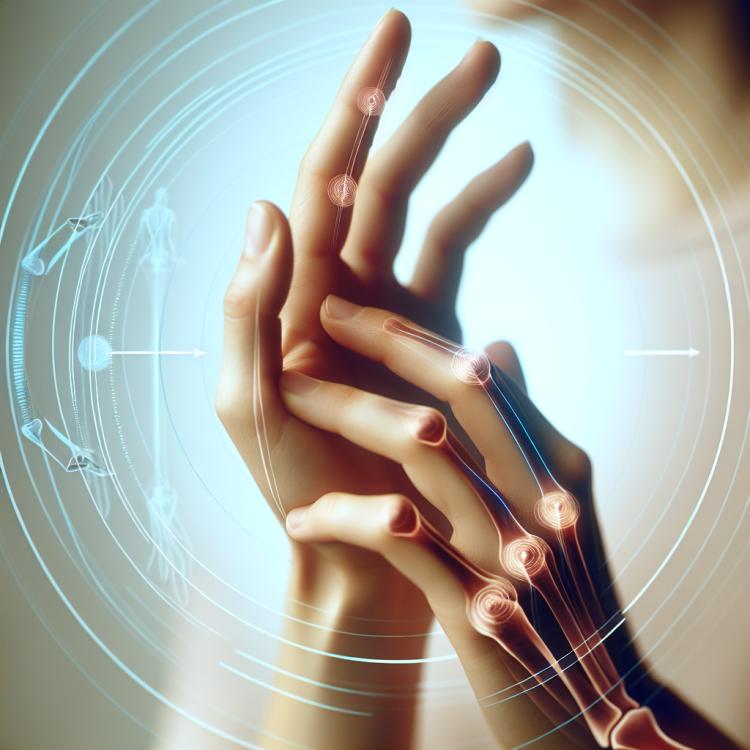
Clicks in joints: causes, symptoms, and treatment
About the Symptom
Clicks in the joints are a phenomenon familiar to many people. This symptom occurs during movement and can be caused by various factors. Usually, clicks in the joints are manifested in the areas of the knees, elbows, fingers, and spine. Although many experience this condition without any pain, it is important to remember that the audible manifestations may indicate the presence of hidden problems with the joints and connective tissues.
The causes of clicks can vary from natural factors, such as the stretching of ligaments and tendons, to more serious conditions, including arthritis, bursitis, or damage to cartilage. It is important not to ignore the occurrence of clicks, especially if they are accompanied by pain, swelling, or limited mobility. In such cases, it is recommended to consult a specialist for diagnosis and to receive qualified medical assistance.
Diseases
Clicks in the joints are a fairly common symptom that may indicate various diseases of the musculoskeletal system. In most cases, such sounds occur when the joints move and are a result of normal physiological processes. However, in some situations, clicks may indicate the presence of diseases that require the attention of a specialist. This is especially true in cases where clicks are accompanied by pain, swelling, or limited joint mobility.
Diseases that may cause clicks in the joints include osteoarthritis, arthritis, bursitis, tendinitis, and ligament insufficiency syndrome. These pathologies can cause changes in the structure of the joints and surrounding tissues, which leads to the characteristic sounds during movement. Therefore, it is important to seek medical attention for diagnosis and treatment, especially if you notice a deterioration in your condition.
- Osteoarthritis
- Arthritis
- Bursitis
- Tendinitis
- Ligament Insufficiency Syndrome
- Gout
- Aneurysm of the Joint Capsule
Diagnosis
Clicks in the joints can be a symptom of various diseases and conditions; therefore, a correctly established diagnosis plays a key role in their treatment. When consulting a medical specialist, the patient may be offered a series of diagnostic measures aimed at determining the cause of the clicks and related symptoms. The initial examination usually includes taking a medical history, where the doctor clarifies the frequency and nature of the clicks, as well as the presence of painful sensations or restricted movement.
In most cases of diagnosis, modern instrumental methods may be required. This may include X-rays, magnetic resonance imaging (MRI), or ultrasound examination of the joints. These studies help visualize the state of the joints, identify possible inflammatory processes, degeneration of cartilage tissue, or other abnormal changes that may explain the appearance of clicks.
List of diagnostic services:
- Consultation with a rheumatologist
- General blood test
- X-ray of the joints
- Magnetic resonance imaging (MRI)
- Ultrasound examination (US) of the joints
- Computed tomography (CT)
- Arthroscopy (in rare cases)
Which doctor to consult
If you are experiencing clicks in your joints, it is important not to ignore this symptom, as it may be a sign of various diseases or conditions. Initially, it is recommended to consult a general practitioner who will conduct a primary examination and determine the need for further investigation. The doctor will be able to assess the nature of the clicks and their connection to pain or mobility restrictions, which will help identify possible causes of this phenomenon.
Depending on the results of the initial examination, you may need to consult a specialist. For example, a rheumatologist specializes in joint and connective tissue diseases. An orthopedist will assist in cases of traumatic injuries or changes related to physical load. You may also need the opinion of a physiotherapist to assess the condition of the muscles and ligaments surrounding the joints and to recommend rehabilitation measures.
- Therapist
- Rheumatologist
- Orthopedist
- Physiotherapist
- Neurologist
Types of Joint Clicks
Clicks in the joints can be caused by various reasons, and their typology may vary depending on the characteristics of the joint and the mechanism of the sound’s occurrence. Some clicks are completely normal and do not require medical intervention, while others may indicate the presence of diseases. It is important to distinguish these types of clicks to assess their potential harm.
There are different types of clicks that can be classified based on their cause and accompanying symptoms. For example, clicks caused by the release of gas from the synovial fluid are usually safe and not associated with painful sensations. At the same time, clicks accompanied by pain or limited mobility may signal problems that require the attention of a medical professional.
- Clicks caused by gas release (eutectic cavitation)
- Clicks associated with injuries or strain
- Clicks due to arthritis or inflammatory processes
- Clicks in distal joints caused by minor joint pathology
- Clicks due to improper positioning of joints or cartilage
Causes of Clicking in Joints
Clicks in the joints can occur for various reasons, and their appearance does not always indicate the presence of serious diseases. One of the most common reasons is the release of gas from the synovial fluid that surrounds the joints. When the joints move, a change in pressure occurs, causing gas bubbles to form, and their bursting results in the characteristic click. This phenomenon typically does not cause pain and does not require medical intervention.
Another reason for clicks may be changes in the structure of the joints, such as degenerative changes that can occur with age. These changes are often associated with arthritis or osteoarthritis, when cartilage wears down, leading to changes in the shape of the joints and their uneven movement. In such cases, clicks may be accompanied by pain and limited mobility, which requires a doctor’s consultation.
In addition, clicks can be the result of injuries, such as sprains or dislocations, which cause the joint to lose its usual stability. It is important to carefully monitor how often clicks occur and whether there are accompanying symptoms such as pain, swelling, or limited mobility. This will help determine if detailed diagnostics and treatment are needed.
- Formation of gas bubbles in the joint fluid
- Degenerative changes and osteoarthritis
- Injuries and joint dislocations
- Developmental disorders of the joints
- Incorrect exercise techniques
Common Related Pathologies
Clicks in the joints can be not only a physiological phenomenon but also a symptom of various diseases. Often, clicks occur as a result of disruption in the normal functioning of the joints, which may be associated with diseases of the cartilage, inflammatory processes, or injuries. One of the most common pathologies associated with clicks is osteoarthritis, which is accompanied by the destruction of cartilage and changes in the structure of the joints.
In addition, such symptoms may be observed in the case of the snapping knee syndrome, when ligaments or cartilage are pinched in the joint. It is equally important to note that clicks in the joints can be associated with such diseases as bursitis, tendinitis, or even gout. All these pathologies require a careful approach and timely diagnosis, as ignoring the symptoms may lead to the progression of diseases and a deterioration in the quality of life.
- Osteoarthritis
- Snapping Knee Syndrome
- Bursitis
- Tendinitis
- Gout
- Rheumatoid Arthritis
- Coxarthrosis
Expert Opinion
Clicks in the joints are one of the common problems faced by patients. Many of them worry that these sounds could be a sign of serious diseases, such as arthritis or osteoarthritis. However, as specialists note, clicks in the joints, especially if they are not accompanied by pain or restriction of movement, can be perfectly normal phenomena. This may be related to the movement of air bubbles in the synovial fluid or the shifting of tendons and ligaments during movement.
Nevertheless, an orthopedist or rheumatologist recommends paying attention to how frequently such clicks occur and what symptoms may accompany them. If the clicks are accompanied by tenderness, swelling, or restriction of movement, this may signal more serious problems, such as inflammatory processes or degenerative changes in the joints. In such cases, it is important to conduct a detailed diagnosis and receive recommendations from a qualified specialist.

Treatment of Joint Clicks
The treatment of joint clicks depends on the underlying cause. In most cases, if the clicks are not accompanied by pain or other symptoms, no special treatment is required. However, if the clicks are a sign of joint degeneration, osteoarthritis, or other conditions, medical assistance may be necessary. It is important to note that the click sound itself is not a pathology, but it may indicate the presence of more serious issues that require careful monitoring.
Treatment may include physical therapy, the prescription of anti-inflammatory medications, as well as lifestyle changes and recommendations to engage in physical activities aimed at strengthening the muscles around the joint. In some cases, steroid injections may be required to reduce inflammation, or even surgical treatment if conservative methods do not yield results.
- Physical therapy
- Medication therapy
- Exercises for muscle strengthening
- Steroid injections
- Surgical intervention (in complex cases)
Complications
Creaks in the joints, although they may be perceived as a harmless phenomenon, can sometimes signal more serious health problems. If the sounds in the joints are accompanied by pain, swelling, or limited mobility, this may indicate the presence of diseases that require careful examination and treatment. It is important not to ignore such symptoms, as they may lead to more complex joint-related pathologies.
One of the most common complications associated with frequent creaking is osteoarthritis. This disease can cause the destruction of cartilage tissue, leading to persistent pain and restricted mobility. Other possible complications include bursitis and tendinitis— inflammatory processes that develop around joints and tendons. Ignoring the signals from your body can lead to the progression of these diseases and a decline in quality of life.
- Osteoarthritis
- Bursitis
- Tendinitis
- Rheumatoid arthritis
- Synovitis